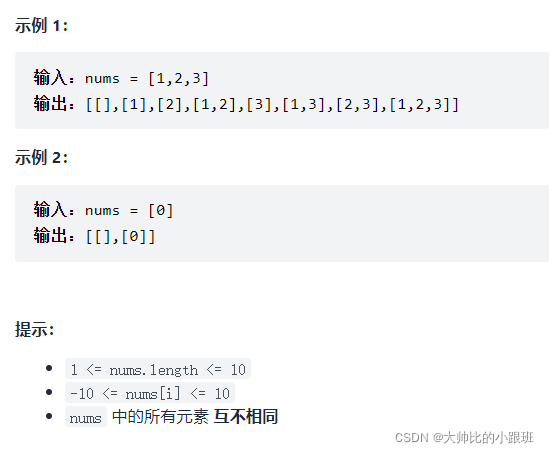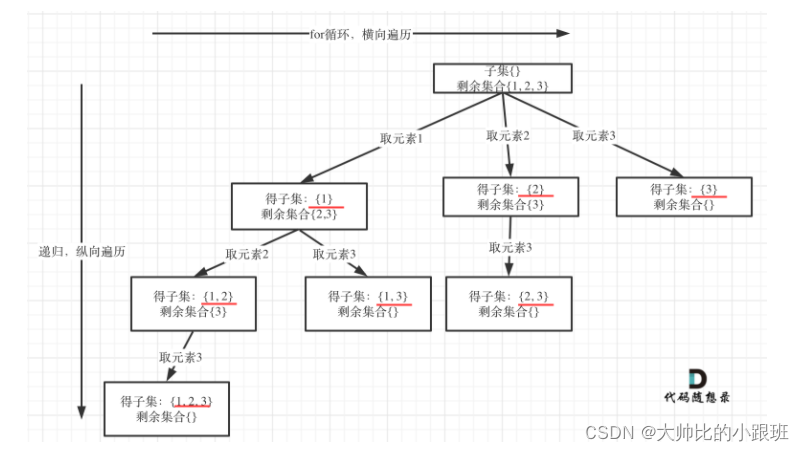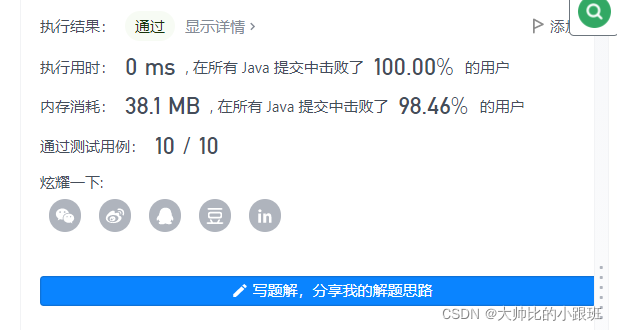给你一个整数数组 nums ,数组中的元素 互不相同 。返回该数组所有可能的子集(幂集)。
解集 不能 包含重复的子集。你可以按 任意顺序 返回解集。

解题思路:回溯
与组合问题相比,组合问题收集的是抽象树结构的叶子节点,而自己问题则是需要收集所有节点。

代码和提交结果如下:
?
class Solution {
public List<List<Integer>> subsets(int[] nums) {
//回溯法
List<List<Integer>> res = new ArrayList();
Stack<Integer> paths = new Stack();
backTracking(res,paths,0,nums);
return res;
}
private void backTracking(List<List<Integer>> res , Stack<Integer> paths ,int startIndex , int[] nums ){
res.add(new ArrayList(paths));
for(int i = startIndex ; i < nums.length ; i++){
paths.push(nums[i]);
backTracking(res,paths,i+1,nums);
paths.pop();
}
}
}
其实可以有递归的判出条件是,startIndex >= nums.lengths,但是因为需要收集所有节点,和for循环结束后完成递归是一个效果,所以没有加。?
给你一个整数数组 nums ,其中可能包含重复元素,请你返回该数组所有可能的子集(幂集)。
解集 不能 包含重复的子集。返回的解集中,子集可以按 任意顺序 排列。

解题思路:这道题目和78.子集?(opens new window)区别就是集合里有重复元素了,而且求取的子集要去重。属于“树层去重”,在传入数组之前需要对数组进行sort,然后使用used数组进行去重,如果 i > startIndex && nums[i-1] == nums[i] && used[i-1] == false,则说明nums[i]同层已经使用过了,需要continue跳过。
代码和实现结果如下:
class Solution {
public List<List<Integer>> subsetsWithDup(int[] nums) {
if(nums.length == 0){
return new ArrayList();
}
List<List<Integer>> res = new ArrayList();
Stack<Integer> paths = new Stack();
boolean used[] = new boolean[nums.length];
Arrays.sort(nums);
backTracking(res,paths,0,nums,used);
return res;
}
private void backTracking(List<List<Integer>> res , Stack<Integer> paths ,int startIndex , int[] nums ,boolean[] used){
res.add(new ArrayList(paths));
for(int i = startIndex ; i < nums.length ; i++){
if(i > startIndex && nums[i-1] == nums[i] && used[i-1] == false){
continue;
}
paths.push(nums[i]);
used[i] = true;
backTracking(res,paths,i+1,nums,used);
used[i] = false;
paths.pop();
}
}
}?
总结: 回溯部分分为? 组合、子集、排列、分割字符串、棋盘问题、递增子序列几个部分,重点在于理解回溯的模板,以及各种去重、剪枝操作。如果可以排序,树层去重可以用used[ ]。